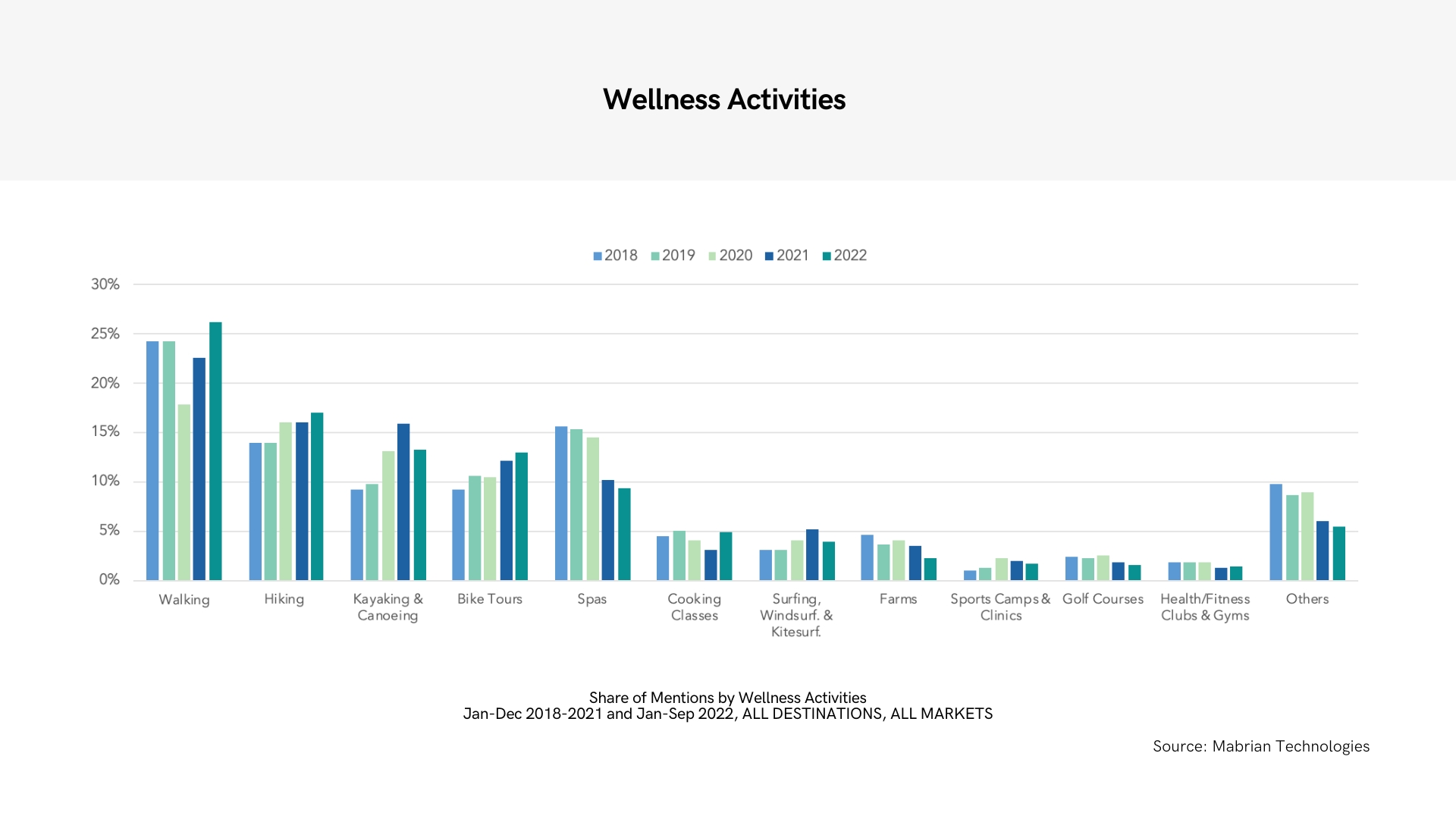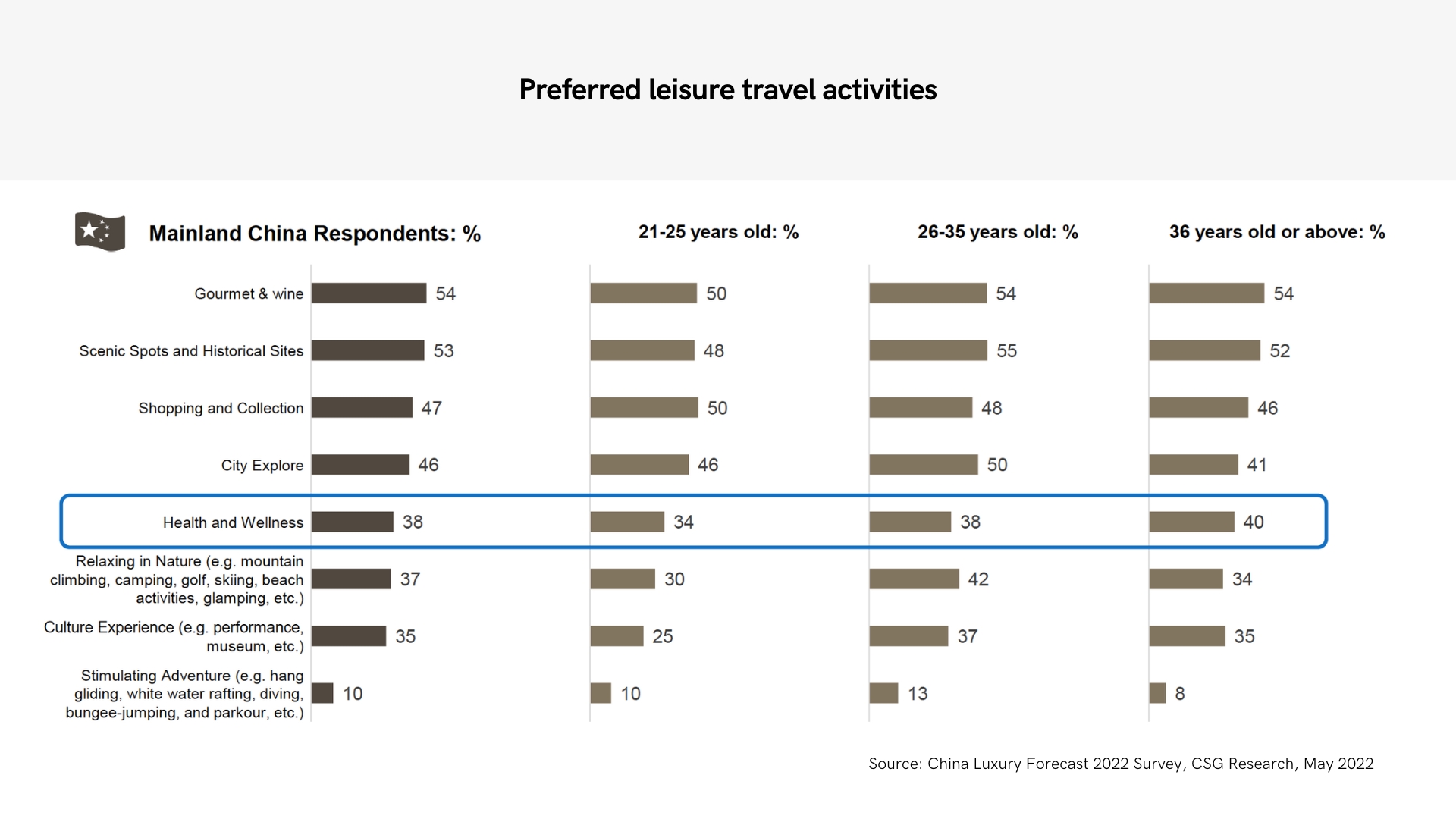News and Insights
The Future of Wellness Tourism
November 22, 2022
As travel gets back on its feet, what does the future hold? At the 2022 Global Wellness Summit held in Tel Aviv, our global travel practice presented a multi-research study identifying the factors shaping tourism’s recovery and how the pursuit of wellness is influencing how we travel.

Image credit: Global Wellness Summit
According to the Global Wellness Institute (GWI), wellness tourism is travel associated with the pursuit of maintaining or enhancing one’s personal wellbeing. GWI valued the wellness tourism market at $720 billion in 2019. This figure has shrunk to $436 billion during the pandemic, with wellness trips dropping from 936 million to 601 million.
But while the pandemic has exacted the heaviest toll on the travel industry, it has also ushered in a wellness revival that is having a profound influence on how we travel. The impressive 21% annual growth rate projected for wellness tourism by GWI through 2025 reflects new traveller values as well as a period of rapid recovery from pent-up demand.
To understand this shift, we partnered with Mabrian Technologies, a travel intelligence consultancy that uses big data analysis to identify and predict consumer trends. We also drew insights from JLL’s Destination 2030 report created in partnership with the World Travel and Tourism Council, which identifies the factors determining cities’ readiness for sustainable tourism growth.
Our Key Takeaways
Looking ahead, wellness tourism’s recovery will depend on three factors:
1. Understanding how changing consumer behaviours towards wellness will impact the development and promotion of tourism destinations, products and programs.
2. Building sustainability as the engine for tourism growth
3. Preparing for the ‘renewed’ outbound Chinese travel segment, which will continue to be the largest travel segment going forward.
Walk This Way: Wellness to Today’s Travellers
Mabrian’s study analyzed travel sentiment on Trip Advisor around wellness activities from 2018 to September 2022. Reassuringly, it reaffirmed that wellness pursuits continued to gain traction over the pandemic years despite the curtailment of travel, lockdowns and quarantine restrictions.
While there were many interesting findings from the study, one in particular stood out for us: Among all leisure activities associated with travel, walking was the most preferred wellness activity above all else.
Why is this a big deal?
Not on our backs, but on our feet

While this may seem like a trivial observation, when taken in a wider context, represents a profound shift in how wellness is viewed today – beyond a more passive form of relaxation (imagine that quintessential massage) to increased physical activity and most importantly, a quest for nature and a deeper connection to the sense of place.
It makes sense that after years of restricted mobility, the singularly most powerful expression of being well is to be able to move. Specifically, to walk. So if immobility was associated with unwellness, conversely the picture of wellness was simply the freedom to move.
Through this lens, the Mabrian study identified the top 20 wellness destinations and Cusco, Peru topped the list primarily because of its hiking trails, which received the highest number of reviews on social media platforms worldwide. While it seemed like a rather random finding, Cusco’s appeal is Machu Picchu’s ancient ruins and lost civilization, nature and heritage. And likely not a spa for miles. For travellers seeking not only a physically challenging but also a spiritually enlightening experience, it made sense why Cusco would be their top choice.
Building Sustainability to Drive Tourism Growth
Travel and tourism have heard the clarion call for sustainability, especially since tourism is blamed for 8% of greenhouse gas emissions. As we “build back better”, we talked to the team at JLL who partnered with the World Travel and Tourism Council this year to do a comprehensive study addressing what makes a city ready for sustainable travel and tourism growth and how it can be achieved.
JLL’s Readiness 2030 report shortlisted 8 pillars with 75 indicators identifying 5 city typologies that showcase the pressure, challenges and opportunities that destinations face as they grow in a sustainable and inclusive way.
The rationale behind each of these typologies are described at length in their report. Suffice to say, the cities who ranked highest in two pillars – Environmental Readiness and Policy Prioritization – tended to be the ones that were primed for sustainable tourism growth.
Are we ready for ‘woke’ Chinese travellers?
It is virtually impossible to imagine tourism’s recovery without factoring the return of China’s outbound travel segment. If there’s one market that plays an outsized role in travel’s recovery yet has been profoundly and permanently altered by the pandemic, it’s China, which continues to endure the strictest travel lockdowns and restrictions as of this writing.
Why does this market remain the linchpin to global travel’s recovery? A decade ago, it was predicted that there would 200 million outbound Chinese travellers by 2020. By 2019, there were 155 million already, and that figure represents only 12% of the population with passports. By all accounts, China will be the number one economy by 2050, eclipsing the US which will fall to #3. India will be in 2nd place. Imagine the potential ahead.
Much has already been laid on the feet of Chinese travel segment – from overtourism to how it’s propping up the global luxury market despite economic downturns. So it begs the question, what will China’s travellers be like when they can travel again?

Our Shanghai team took a look at this and they’ve found that Chinese consumers have prioritized wellness much more over the past two years, with wellness shifting from physical to mental, especially among the younger demographics. A proprietary report conducted by CSG on affluent Chinese travellers also confirms this finding: health and wellness pursuits are in the top 5 of most preferred travel activities and caring for their physical and mental health is having a lasting impact on their lifestyles.
Because of continuing travel restrictions, wellness tourism in China has been largely concentrated domestically. This segment has grown significantly, with over 6,000 domestic enterprises engaged in wellness tourism. What’s emerging is a market segment, long associated with marathon shopping trips to one that is avidly seeking “healing hikes,” temple stays and wilderness car trips.
A good example of this phenomenon is The Feiwen Yeshe Hotel in Hangzhou, which offers three residences—one adjacent to a temple, one hidden in the mountains, and one located in the wilderness.
Incidentally, this trend is also something we’ve found among travellers in other key North Asia markets Japan and South Korea.
Heads or Tails?
In the short to midterm, travel’s recovery will be hampered by headwinds: economic uncertainties, the ongoing Ukraine/Russian war, the climate and energy crisis, and labour challenges.
But taking a long term view, the prospects far outweigh the challenges. The wellness imperative will continue to define how we develop and market products as the quest for wellness will only continue to grow across all demographic and psychographic segments. Technological advances are accelerating how wellness is delivered across sectors. Destinations are building back better, and we can count on the immense potential posed by emerging economies in the coming decades.
Travel’s Resilience
We can gain a glimpse of travel’s future by looking back. In the last 30 years, tourism’s incredible and proven resilience has been tested through economic downturns, terrorism, regional conflicts and now a global pandemic. Time and again, travel bounces back.
That the pandemic has forced our industry into a time of radical self-correction could be a blessing in disguise. It has also accelerated the transition to more sustainable models of tourism growth and an opportune time for all of us in the broader travel and hospitality sector, to build more inclusively and resiliently so that destinations are not just great places to visit but to live in as well.
Download the full Mabrian study here.
-
TAGS:
- Wellness